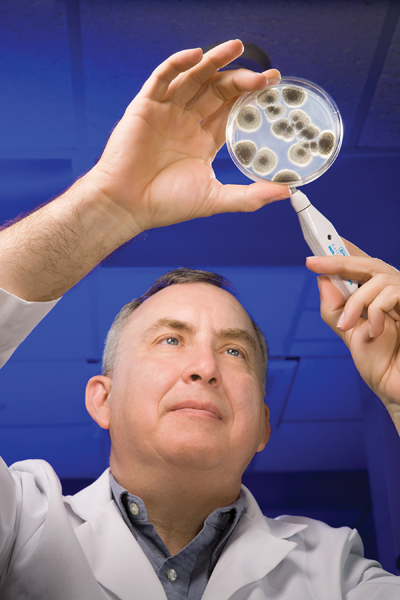
Features
Production
Research
Pepper compound mighty against mould
September 25, 2009 By Rosalie Marion Bliss
Dried, ground cayenne peppers have been spicing up cuisine and have been used medicinally for thousands of years.
Dried, ground cayenne peppers have been spicing up cuisine and have been used medicinally for thousands of years.
But in just the last decade, U.S. Department of Agriculture (USDA) Agricultural Research Service (ARS) microbiologist Anthony De Lucca and colleagues have reported evidence that cayenne pepper contains novel antifungal plant compounds within the saponin chemical family. As a result, in 2001 USDA-ARS patented a pepper saponin extract named “CAY-1” that has fungicidal properties.
 |
|
| Microbiologist Anthony De Lucca observes the lethal effects of CAY-1 on an Aspergillus japonicu isolate from infected vineyard grapes. (Photo by USDA-ARS)
|
De Lucca is with the Food and Feed Safety Unit at ARS’s Southern Regional Research Center (SRRC) in New Orleans, Louisiana. He and his colleagues recently published a new study showing that CAY-1 holds promise in laboratory experiments as a fungicide against several grape pathogens. This work was published in 2008 in the American Journal of Enology and Viticulture.
“The CAY-1 extract is a fast-acting plant compound that is lethal to micro-organisms,” says De Lucca. “It begins to kill within 10 minutes.”
Saponins are believed to attach to fungal membranes where they cause cell components to leak, followed by cell death. Saponins also enter fungal cells and disrupt certain signaling pathways that, in turn, damage the cells’ mitochondria, or power plants.
For the study, De Lucca and SRRC colleagues isolated members of 10 fungal genera from diseased grapes grown in a hot, humid environment. Some of these are primary or secondary grape pathogens. Primary pathogens directly cause infection, whereas secondary pathogens infect after the host’s defenses have been compromised by stress, injury, or other infection.
The researchers tested CAY-1 against these fungi in the laboratory. CAY-1 was lethal during the early spore germination cycle of seven of the fungi, but was inactive against the nongerminated, or dormant, spores. While CAY-1 was lethal to primary and secondary grape pathogens, additional research is required to indicate whether, and how, the compound could be used safely on grapes.
The SRRC researchers have also recently collaborated with physician Dr. Thomas Walsh and others at the National Institutes of Health (NIH), in Bethesda, Maryland, to study CAY-1 activity against Microsporum canis and Trichophyton rubrum, which are dermatophytic, or skin, fungal pathogens that infect immunocompromised individuals. The study showed that CAY-1 is active in the laboratory against these skin pathogens.
“CAY-1 was effective against 18 isolates of these two fungi,” says De Lucca. That study was published in 2008 in the journal Medical Mycology.
Earlier work by both the SRRC and NIH researchers showed that CAY-1 was also slightly active against certain Fusarium species that cause disease in plants and humans.
These studies indicate that CAY-1 holds promise for dual use as an antifungal in both agriculture and medicine. “The same destructive pathogens that cause problems agriculturally, for example, Aspergillus and Fusarium genera, can also be lethal infectious agents in immunocompromised individuals,” says De Lucca.
Rosalie Marion Bliss is a member of the Agricultural Research Service Information Staff.
Print this page